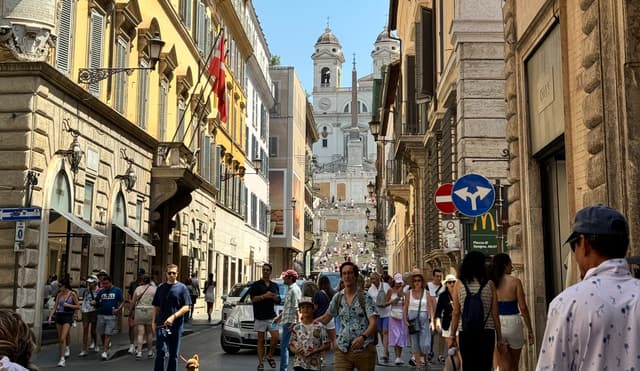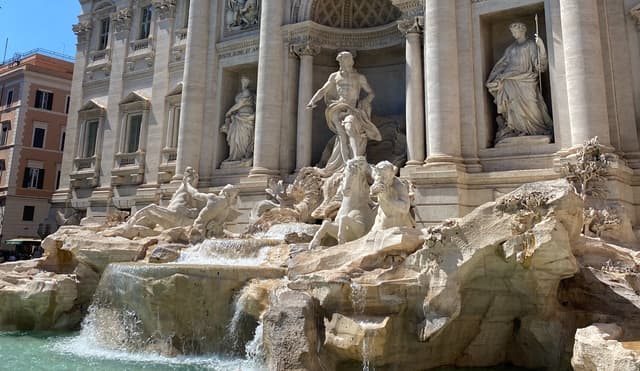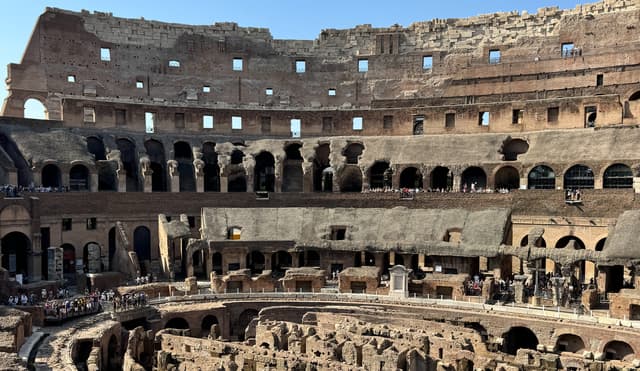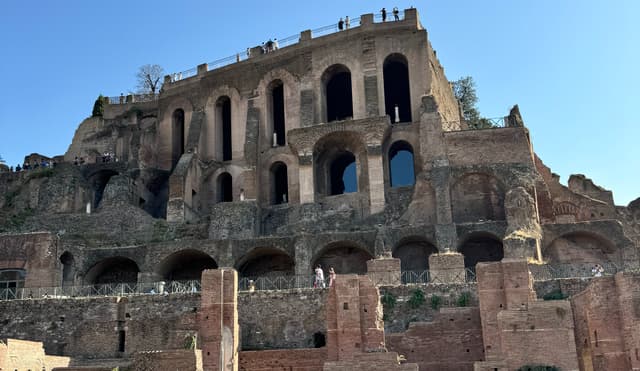5-Star First Timer’s Guide: 1-2 Day Rome Itinerary 🍝

This Eternal City evolved from a small settlement into the capital of a vast empire, and now, a major European city—making Rome your Italian gateway to the past where you can experience ancient history firsthand.
Stroll the grounds of gladiators or gaze upon the ruins of Caesar's bygone city center; everywhere you look, dramatic tales arise with whispers of a former world.
Alongside this history lesson come to life find the tasty regional Roman cuisine which distinctly stands apart from other destinations around the country—dig into carbonara, cacio e pepe, and gricia to delight in local delicacies!
No matter how you spend your time in Rome, a one-day stop in Italy’s capital is sure to be a delightful introduction to this artistically romantic culture.
One Day Rome Itinerary 🗺️
In a hurry? Here’s a time-stamped itinerary detailing the can't-miss things to do in Rome during one extravagant day walking around the city:
10:00 - 10:30 AM: ⛪ Stroll around the Spanish Steps window shopping and people watching (30 min)
10:30 - 11:45 AM: ☕ Grab cannoli and coffee from 18th-century favorite, Antico Caffè Greco (45 min)
11:45 AM - 12:15 PM: 🪙 Toss a lucky coin over your shoulder into the Trevi Fountain and make a wish! (30 min)
12:15 - 12:45 PM: 🏛️ Continue to the Pantheon to gaze upon perfectly preserved Roman architecture (30 min)
2:15 - 3:00 PM: 🍰 Gaze upon the most controversial “wedding cake” monument in Rome, Vittoriano (45 min)
3:00 - 4:15 PM: 🤼 Walk the ancient battleground of gladiators as you tour the Colosseum (1 hr 15 min)
4:15 - 5:15 PM: 📜 Experience the previous center of public Roman life within the Roman Forum (1 hr)
5:15 - 6:15 PM:🍦 Try Rome’s #1-rated dessert spot (yes, seriously!) on TripAdvisor, Gelateria Pasquino (1 hr)
6:30 - 8:15 PM: 🏨 Return to your haute hotel to rest and freshen up before a fancy dinner (1 hr 45 min)
8:30 - 11:15 PM:🪿 Dig into the best meal of your life at 2-Michelin star Enoteca La Torre (2 hr 45 min)
In actuality, I accomplished the following itinerary over two days after arriving late in the afternoon following my flight over to Rome. That being said, you could absolutely fit everything described above into a one day in Rome itinerary.
Or take it easy, sleep in, and explore at a leisurely pace if you have time to spread this 5-star Rome travel guide describing the best things to see, do, and eat over two days.
Where to Stay in Rome? 🛌🏽
Offering refined Italian style and elegant sophistication, the Hotel Splendide Royal in the heart of Rome is a centrally located 5-star jewel with irresistible charm.

How to Spend 1 Refined Day in Rome? 🏛️
Follow the below itinerary in the recommended order to ensure you're maximizing your day in the Eternal City!
(P.S. All these restaurants can accommodate gluten-free diners!)
⛪ Spanish Steps
Begin your day with a leisurely walk down one of Rome’s most iconic landmarks, the Spanish Steps.

☕ Antico Caffè Greco
Steps away from the steps (get it?) down Via dei Condotti you’ll find Antico Caffè Greco, where John Keats and Lord Byron once drank coffee at the marble tables of this celebrated, richly-ornate 18th-century cafe.

🪙 Trevi Fountain
After your quick coffee break it’s time for another historic landmark, next up is Rome’s most notable water feature — the Trevi Fountain!

🏛️ Pantheon
Up next is yet another piece of inspiring history: the Pantheon.


🍝 Lunch - Virginiae
Although you can find a host of spots within this piazza to grab lunch, I’d recommend enjoying a plate of cacio e pepe from traditional Roman restaurant Virginiae, located down Via di Tor Millina just behind Borromini's church.

🍰 Vittoriano
After lunch, continue your sightseeing to the controversial layered "wedding cake” more formally known as the Victor Emmanuel II Monument or Vittoriano.

🤼 Colosseum
You’re not done sightseeing just yet—Rome has more than enough global cultural treasures to fill up one day!
Walk 13 minutes down Via dei Fori Imperiali to arrive the most iconic enduring legacy of ancient Rome, the Colosseum or Flavian Amphitheater.

📜 Roman Forum
Just next door you’ll find the Roman Forum, the heart of ancient Rome which served as the center of public life for centuries, today persisting as a symbol of this enduring legacy.

🏺 Palatine Hill
Inside the larger Roman Forum archaeological park is also Palatine Hill, the residential center of ancient Rome home to many elites who built their imperial palaces on the hill.

Since all three of these landmarks are so close together—the Colosseum, Roman Forum, and Palatine Hill that is—you might as well explore all of them around the same time, and the €18 combined 24-hour admission ticket allows you to do just that!
This ticket is sold for the exact same price as the variations granting entry to the individual landmarks, so you won’t be spending any extra dough seeing them all in the same day!
🍦 Dessert - Gelateria Pasquino
After a full day of exploring this last stop is going to be a bit of a final trek before returning to the hotel, but I promise it’s worth it since you’ll be visiting the #1 ranked dessert out of 950 spots in Rome on TripAdvisor at the time of writing!

🪿 Dinner - Enoteca La Torre
For dinner, prepare to indulge in the fanciest, most delicious dinner you’ve ever had in your life at this two Michelin star, three Gambero Rosso fork masterpiece situated within the aristocratic Hotel Villa Laetitia.

How to Get Around Rome?
🚶♀️WALK
As I recommended in most European cities, walking is usually the best way to go if the journey takes anywhere between 20-30 minutes.
🚕 TAXI:
Request a cab in your hotel lobby or call one yourself on Uber or FreeNow to see the estimated wait time and duration up front.
I used both mobile apps for my taxi transportation needs and at least one of these two options was always able to offer me a swift ride.
The base fare for taxis is €3.50, with an added charge of €1.10-1.70 per kilometer during the day—with Fiumicino Airport transfers having a fixed rate of €55 to the city center and Ciampino Airport having a fixed rate of €40.
The vast majority of taxis accept credit cards as a payment method—which is always guaranteed if you’re ordering a ride on Uber or FreeNow anyways.
🚌 BUS:
Truth be told, I’ve never taken any form of public transportation in Rome. I either walked around the city center or was so tired and sweaty I was willing to call a cab.
Since traffic often causes bus delays—especially around landmarks with the most tourist congestion—and the limited metro network only includes 3 subway lines, I’d recommend just walking around on the single day you’re planning to spend in Rome.
This will be quite simple when following the above itinerary, with the only place you may want to take the bus being Enoteca La Torre—but if you’re going out to a fancy dinner anyways, you'll probably want to call a taxi as opposed to getting on the bus in heels!
What to Wear in Rome? 👗
Fashion in Rome blends timeless elegance with pieces that can practically endure the summer heat, ensuring you’re comfortable enough to spend all day exploring while still capturing the city's effortlessly chic vibe.
A rich historical tapestry dotted with ancient landmarks, Rome invites you to embrace a classic yet relaxed style where sophistication meets everyday wear.
Light neutral tones such as beige, white, and soft pastels are a natural choice, especially since they won’t absorb heat to the extent that a little black dress would! I wish I would've followed my own advice on this one, since I had to change outfits THREE times during our July summer visit!
Lightweight fabrics like linen and cotton are a MUST when it comes to staying cool under the Roman sun.
As for footwear, opt for fashion-forward flats crafted with interesting leather strap configurations, since Rome’s cobblestone streets require shoes which convey style while offering stability.
If you're keen on blending with the locals, consider simple, well-tailored pieces elevated with contrast stitching or a belt tied around your bodice to seamlessly incorporate visual interest without the need for added clothing layers.
Think classic Italian refinement but with a breezy, laid-back twist perfect for the city’s warm summer days.
How Much Does One Day in Rome Cost? 💶
Following the above itinerary led the cost of a luxurious one day, two night trip to be $1,035.45 for me as a young 20-something on a couples trip in Rome:
Lodging 🏨
- $545.72 - two nights in Hotel Splendide Royal, split amongst two people
Transportation 🚗
- $21.79 - taxi ride from the Roman Forum to Hotel Splendide Royal
- $35.96 - taxi rides to and from Enoteca La Torre departing from Hotel Splendide Royal
- $57.20 - Uber ride to the airport from Hotel Splendid Royal
Food 🍝
- $37.05 - two coffees and a cannolo from Antico Caffè Greco
- $4.36 - water from Terre E Domus
- €4 - medium gelato cup from Gelateria Pasquino
- $303.45 - two Michelin star meal from Enoteca La Torre
Activities 🏛️:
- €18 - 24-hour Colosseum and Roman Forum admission ticket
How to get from Florence to Rome?🚉
FROM: Firenze Santa Maria Novella (Piazza della Stazione, 50123 Firenze FI, Italy)
TO: Roma Termini (Via Giovanni Giolitti, 40, 00185 Rome, RM, Italy)
TRANSPORTATION: Trenitalia high-speed FRECCE trains (1 hr 59 min, direct, ~€45)
If you’re truly embarking on a tour of Italy and only stopping in Rome for a day, it’s very likely you’re coming from another Italian destination or using Rome’s international airport as your starting point before venturing further into the country.
In that case, a northern Italy exploration will likely take you through Florence, since it’s the next closest major city before Milan and Venice!
Fortunately for you, Florence is my absolute favorite place I’ve visited in all of Italy and it’s only an hour and a half away from Rome by train!
You can easily travel to Florence by hopping on one of the many Trenitalia routes departing from Roma Termini to Firenze Campo Marte, which run every 15 minutes during the day and cost ~€45 one way for base economy tickets.
Since you’re traveling within the country, there’s nothing more you need to do other than show up at the station and hop on the correct train!
Racks are available to store luggage, and most of these longer-distance trains have comfortable seats with outlets and tray tables like what’d you expect to find from any typical airline offering!
Is Rome Worth a Stop on Your Italy Tour? 🇮🇹
The first time I visited Rome in 2022 was truly for a single day after an extremely hungover train ride following wine tasting in Florence, so you can imagine how well prepared I was to receive the city.
Prior to my recent return, I would’ve said Rome was an okay Italian destination but couldn’t compare with Florence or Lake Como, since I really only remembered walking around for hours on end during a hot, humid summer day.
Not that anything was too different this time around—since it was so hot we returned to our hotel 3 times to change clothes!—but without a pounding headache I was immensely more impressed by the ancient architecture found all around.
Rome is really one of those cities that takes you all the way back in time, preserving structures that would otherwise be incomprehensible to the modern mind.
I guarantee that if you haven’t visited Rome before, you truly can’t imagine the monumental size of the Colosseum—or even the Trevi Fountain for that matter—which is why doing the typical “touristy” things on an initial visit is extremely worth it.
On any future visits you have more than enough time to explore local spots outside the city center like hip Trastevere or lesser known landscapes like the Villa Borghese, but the most notable landmarks have earned that reputation for a reason—and making all the expected stops is necessary to get the authentic taste of ancient Italy that only Rome can provide.
So to address my original question—yes, you should absolutely stop by Rome on your Italy trip! Not only will you explore the country’s capital, but you’ll also be able to embark on a sensory journey through layers of history made out of entire civilizations in one of the oldest continuously occupied cities in Europe!
✈️ Find this guide useful?
It would mean the world if you:
💾 SAVE this guide
☘️ GIFTED a small tip—my go-to coffee order while I'm sitting in cafés curating more travel advice is a $5 iced lavender latte from Alfreds!
The home for unique & authentic travel
